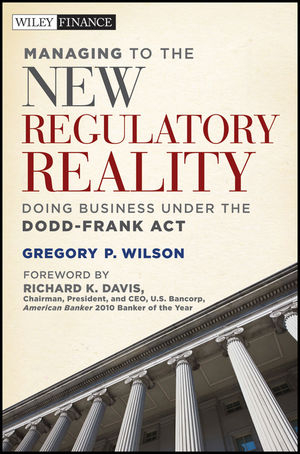
Managing to the New Regulatory Reality
John Wiley & Sons Ltd (Verlag)
978-0-470-87439-4 (ISBN)
- Titel ist leider vergriffen;
keine Neuauflage - Artikel merken
How to manage and profit from the new financial regulatory reality Now, more than ever, navigating the new financial regulations is paramount for the survival of many large institutions. Managing to the New Regulatory Reality: Doing Business Under the Dodd-Frank Act provides the most important, need-to-know lessons for private sector management, boards of directors, policymakers, and even regulators, shedding light on the movement from crisis to panic, regulatory reform to winning under continuing financial regulatory uncertainty. * Reviews the causes of 2008's financial crisis, and assesses its impact on multiple stakeholders * Describes and analyzes the impact of the immediate U.S. and G20 policy and regulatory reactions on financial institutions that the crisis response triggered * Explains the legislative policies, and examines how institutions and the financial services industry can make these new policies and regulations work for them All financial institutions, but especially large companies, will have to aggressively manage to the new regulatory reality.
Managing to the New Regulatory Reality is the must-have survival guide to sustaining profitability despite all the new red tape.
Gregory P. Wilson is the founder of his own consulting firm specializing in financial policy and regulatory issues and is a former part-ner in McKinsey & Company's Washington, D.C., office. Prior to joining McKinsey, during the U.S. savings and loan crisis, he served as the deputy assistant secretary for financial institutions policy at the U.S. Treasury Department, where he received the Secretary's Distinguished Service Award. For more information, visit www.gregwilsonconsulting.com.
Foreword. List of Acronyms. Preface. Part One Understanding the Immediate Political Reactions. Chapter 1 Immediate U.S. Reaction The Emergency Economic Stabilization Act of 2008. All Roads Ultimately Lead to Congress. How a Crisis Bill Becomes an Emergency Law. EESA's Major Provisions. Conclusion. Chapter 2 Rise of the G20 - A Global Call to Action. A New International Financial Order. Toward a Balanced Approach. Conclusions. Chapter 3 The Beginnings of the New Regulatory Reality. Democracy Can Act Swiftly in a Crisis. Problems at a Small Minority of Firms Create Lasting Industry Problems. Populist Anger Drives Unintended Consequences. When Governments Intervene to Protect Taxpayers, Strings Are Attached. Crises Have Long Political and Regulatory Tails. Safety Valves Don't Always Work as Expected. International Crises Command Global Responses. Conclusions. Part Two: Understanding U.S. and G20 Regulatory Reforms. Chapter 4 The U.S. Legislative Process. Administration Proposal. House Consideration. Senate Consideration. Conference Consideration. Conclusion. Chapter 5 The Dodd-Frank Act of 2010. New Regulatory Architecture. New Regulatory Standards. New Operating Restrictions. Higher Regulatory Costs. Conclusions. Chapter 6 Beyond the U.S. - Current G20 Efforts. G20 Agenda Going Forward. IMF Review of U.S. Financial Sector Assessment Program, 2010. International Industry Response. Conclusions. Part Three Preparedness: 10 Lessons for Winning in the New Regulatory Reality. Chapter 7 Set the Right Leadership Tone at the Top. Background. Corporate Leadership. Leadership in Society. Leadership on Public Policy. Implications. Chapter 8 Tell a Good Story. Background. What Individual Firms Can Do. What the Industry Must Do. Implications. Chapter 9 Be Politically Adept, Not Tone Deaf. Background. New Legislative Mandates for Executive Compensation Limits. Consumer Protection. Implications. Chapter 10 Advocate Constructively for Better Outcomes. Background. No Shortage of Future Policy Debates. The Importance of Balanced Policy Objectives. Broader Issues: Getting Back to Competitiveness. Implications. Chapter 11 Manage Strategy and Regulatory Risks Together. Background. Strategy and Regulatory Risks after the Dodd-Frank Act. Implications. Chapter 12 Maintain Fortress Strength at all Times. Background. New Basel III Requirements. New Capital and Liquidity Requirements in the Dodd-Frank Act. Implications. Chapter 13 Live Good Governance. Background. The Value of Good Governance. Recent Regulatory Efforts to Improve Corporate Governance. IIF Principles. Implications. Chapter 14 Plan Carefully for Contingencies. Background. U.S. Rapid Resolution Plans. Implications. Chapter 15 Engage Regulators on Warning Signs. Background. Making sense of crises warning signs. The New Official U.S. Role in Identifying Financial Crises. An Industry Action Plan on Early Crisis Detection. Implications. Chapter 16 Build Trust-based Supervisory Relationships. Background. Building Trust-Based Supervisory Relationships. Improve Supervisory Relationships to Avoid Negative Regulatory Consequences. Implications. Chapter 17 Conclusion - Be Prepared! Implications for Financial Companies. Implications for the Financial Services Industry. Notes. Additional Resources. Acknowledgments. About the Author. Index.
| Erscheint lt. Verlag | 1.4.2011 |
|---|---|
| Reihe/Serie | Wiley Finance Editions |
| Vorwort | Richard K. Davis |
| Verlagsort | Chichester |
| Sprache | englisch |
| Maße | 160 x 233 mm |
| Gewicht | 600 g |
| Themenwelt | Recht / Steuern ► EU / Internationales Recht |
| Recht / Steuern ► Wirtschaftsrecht ► Bank- und Kapitalmarktrecht | |
| Wirtschaft ► Betriebswirtschaft / Management | |
| ISBN-10 | 0-470-87439-2 / 0470874392 |
| ISBN-13 | 978-0-470-87439-4 / 9780470874394 |
| Zustand | Neuware |
| Haben Sie eine Frage zum Produkt? |
aus dem Bereich


